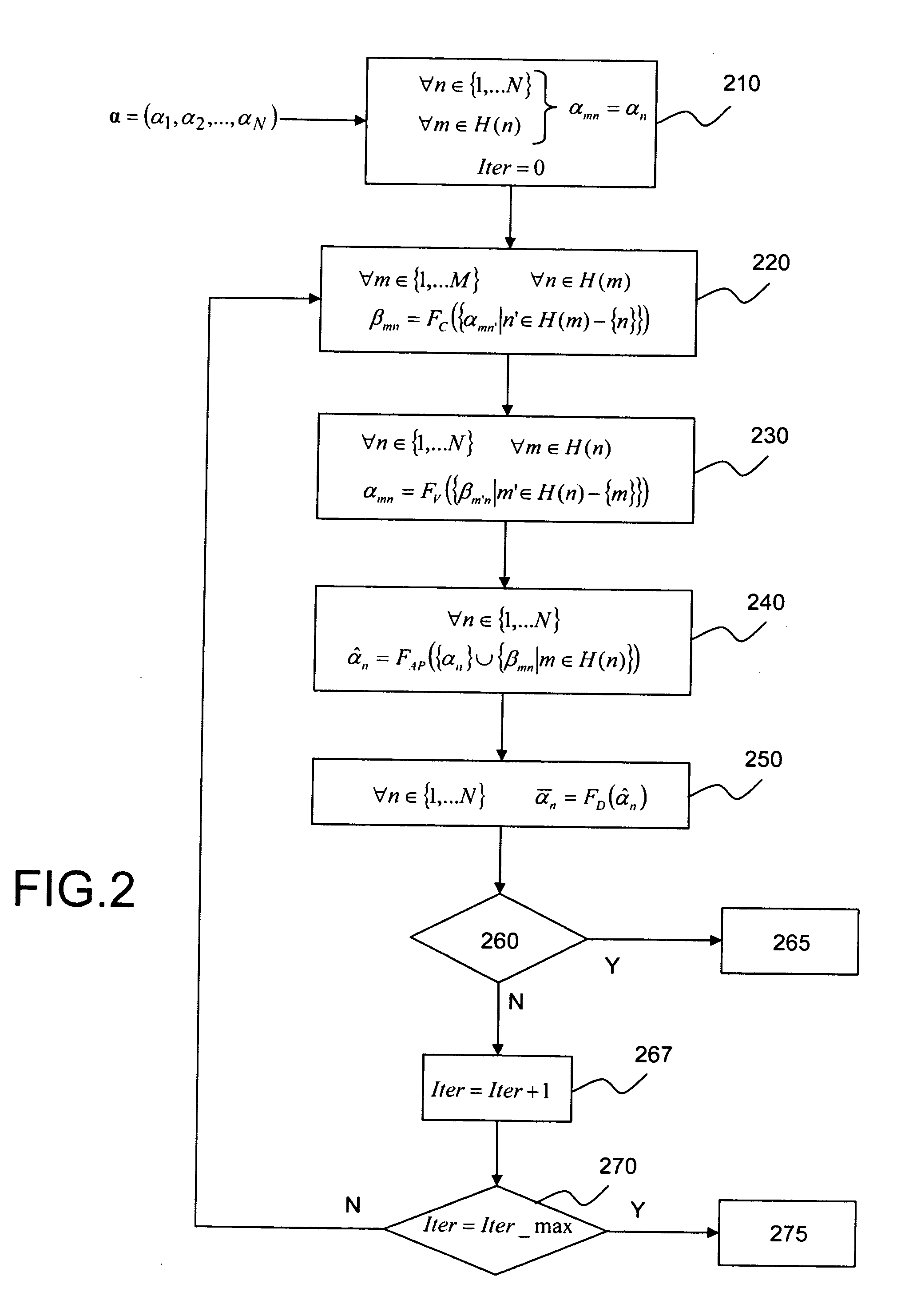Message- passing and forced convergence decoding method
a decoding method and message technology, applied in the field of decoding error correcting codes, can solve the problems of loss of performance relative to the spa decoding algorithm, error correcting codes, and performance degradation of error correcting codes
- Summary
- Abstract
- Description
- Claims
- Application Information
AI Technical Summary
Benefits of technology
Problems solved by technology
Method used
Image
Examples
first embodiment
[0076] alternative, the amplitude reduction operation |αmntemp| is non-linear, for example a thresholding operation. The values αmn are then updated by:
αmn=sgn(αmntemp)·min(|αmntemp|,αmnT) (23)
where αmnT is a positive threshold value associated with the variable node n and with the control node m. To advantage, the thresholds αmnT, 1≦m≦M, 1≦n≦N are obtained adaptively. To be more precise, they are initialized (at 310) by the absolute values of the a priori information i.e. αmnT=|αn| and then updated by means of a law of adaptation.
[0077]According to a first law of adaptation example, for each node pair (n,m), the current iteration threshold value is equal to the absolute value of the extrinsic information of the previous iteration, in other words the calculation of the expression (23) is preceded by the operation:
αmnT=|αmn| (24)
[0078]Thus, in the event of a sign switch, the amplitude of the message αmn in the current iteration is limited by the absolute value of the message from t...
second embodiment
[0081] the amplitude reduction operation is linear (in terms of LLR). In other words, if a sign switch is detected, the amplitude of the extrinsic information is attenuated:
αmn=λαmntemp (27)
where λ is a coefficient such that 0−b will be selected with b a strictly positive integer.
[0082]The coefficient λ may be chosen to be adaptive.
third embodiment
[0083] the amplitude reduction operation may be a combination of a linear operation and a non-linear operation, for example a thresholding operation and an attenuation operation as described previously. The extrinsic information is then updated by combining (23) and (27):
αmn=sgn(αmntemp)λ·min(|αmntemp|,αmnT)
[0084]Other alternative embodiments of the amplitude reduction operation, linear or non-linear, adaptive or not adaptive, are also conceivable without departing from the scope of the present invention. Among non-linear operations origin based sigmoid functions may be of particular use.
[0085]The invention has been described for a parallel sequencing starting with the control nodes. It is however clear for the man skilled in the art that it also applies to parallel sequencing starting with the variable nodes. It also applies to serial and hybrid sequencings as defined above.
[0086]FIG. 4 can be used to compare the performance in terms of error rates (BER) of conventional Min-Sum and...
PUM
 Login to View More
Login to View More Abstract
Description
Claims
Application Information
 Login to View More
Login to View More - R&D
- Intellectual Property
- Life Sciences
- Materials
- Tech Scout
- Unparalleled Data Quality
- Higher Quality Content
- 60% Fewer Hallucinations
Browse by: Latest US Patents, China's latest patents, Technical Efficacy Thesaurus, Application Domain, Technology Topic, Popular Technical Reports.
© 2025 PatSnap. All rights reserved.Legal|Privacy policy|Modern Slavery Act Transparency Statement|Sitemap|About US| Contact US: help@patsnap.com



